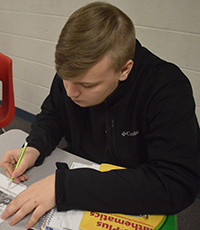After being placed on a list of low-achieving schools in 2010, the district’s high school swung into action. Now, some of its practices are being studied as models of improvements for other districts.
From its lowest point in the 14th percentile ranking among Michigan schools, Kent City has moved as high as the 88th percentile in recent years. That’s thanks to a school improvement plan that high school Principal Bill Crane said brought collaboration to staff and students, along with literacy goals and shared language.
One aspect of the plan was increased communication among instructors across subjects. Students find themselves on familiar terrain as they move on to other subjects, regardless of the content or material, explained Crane, who became an administrator in 2011 as initial plans for the changes were being made.
“We have a lot of very good teachers who are working very hard,” Crane said. “(But) they were on their own, would go in their own classroom and shut the door and teach.
“We wanted to be able to build on everyone’s strengths, getting folks together to talk about instruction, but also coming up with common language.”

Close Reading
One practice students can expect in all middle and high school classes is close reading — short reading assignments that students pore over carefully, taking notes in the margins and picking apart details. The readings are often on topics that relate classroom subjects to current events and real-world applications.
Sophomore Clay Davis said he has come to enjoy close reading, which has touched on current events and topics such as chemistry that he finds interesting.
“It’s nice to have the marginalia and circled words,” Clay said. “I’ve learned a whole span of vocabulary from close reading.”
Math teacher Chad Dailey said close reading was a good fit for the department because of the curriculum’s emphasis on story problems.
“There was buy-in at the high school right away,” Dailey said. “It lends to that because they start to see what the key ideas are, or what they’re trying to find.”
Close readings take place every week, and prepare students for reading-rich standardized tests such as the M-STEP, Crane said, while also providing relevance for class material.
“Lessons shouldn’t be a surprise for kids,” Crane said. “Whether it’s in their biology class and they go to Algebra 1, the teacher’s using the same kind of language.”

Gradual Release
Another element of Kent City’s plan is gradual release of responsibility, which shifts the traditional lecture structure of classroom learning to more student-led collaboration.
“Collaborative group work gives us a lot more time to bring our ideas out, instead of the teacher’s ideas,” Clay said. “A teacher can only keep up with so many kids who are behind. When you stick them into groups it’s a lot easier for everyone to keep up.”
In Dailey’s math class, students help one another through the trials of trigonometry.
“It develops team-building skills,” sophomore Noah Tracey said. “Having a partner, instead of having to wait for the teacher to come around because there’s one teacher for 30 people.”
Added freshman Kristen Toporski, “I think it’s easier for everybody. You can work together.”

A Learning Community
Representatives from the state’s School Reform Office visited Kent City in March to learn how the improvement plan has paid off. The goal is to create a dashboard of proven strategies in schools that have improved, so new high-need priority schools have a template for their own plan.
Although improving test scores is the unit of measurement for the various improvements, Crane said he notices the impact in the hallway every day.
“It’s amazing to me, over five years, to see the growth in kids and how they talk,” he said.”They’re not just talking about their weekends. They’re having conversations about whatever the content is for that class, common themes that help in every class.”
In addition to the core goals of the plan, students and teachers begin the year in four “family” groups to strengthen relationships through team-building and conversation. The school families meet every two weeks throughout the year.
“If you can get everyone in the building working in the same direction, you can accomplish something.” — high school social studies teacher Bob Boyd
Social studies teacher Bob Boyd, who has taught in the district for 32 years, said bonds have formed among students and staff.
“The culture has changed,” Boyd said. “It’s given every student one teacher they feel close enough to go to if they need help, even in life.
“Because of the teachers buying in, the kids have bought in. If you can get everyone in the building working in the same direction, you can accomplish something.”
CONNECT
Article: Closing in on Close Reading Close reading
Gradual release of responsibility









